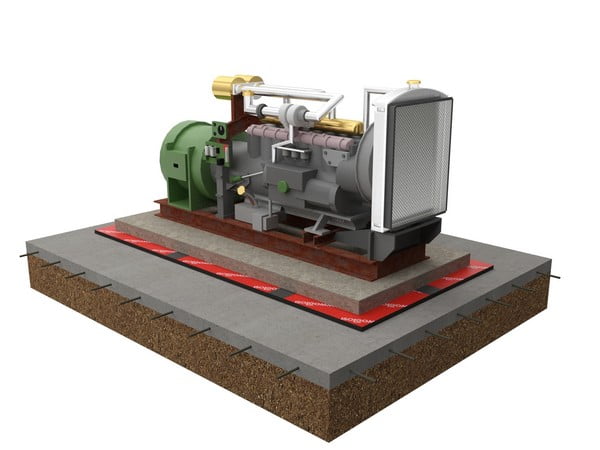

The use of recycled fibers and materials encourages recycling while reducing the environmental footprint of soundproofing installations. Impact noise occurs from activities such as walking, moving furniture, or using appliances like washing machines, while airborne noise includes sounds like conversations, music, and television. Most underlays come in sheets or rolls and can be cut to size using simple tools like a utility knife. These options support environmentalism by reducing the need for virgin materials and lowering overall pollution. In rooms with underfloor heating, selecting an underlay with low thermal resistance ensures that heat can transfer efficiently without being obstructed by the soundproofing material.
When considering soundproofing methods, acoustic underlays provide a reliable way to reduce noise pollution, improve room acoustics, and create a more comfortable environment. Soundproofing Material Products from this Soundproofing Supplier are affective acoustic solutions. Buildtec Acoustics provides underlays with specific properties that address either airborne or impact noise. By utilizing high-density materials like crumb rubber and cork, acoustic underlays efficiently control noise, reducing its impact on people in adjacent rooms or units. Adhesive or double-sided tape can be used to secure the underlay in place, ensuring tight seams between pieces to prevent gaps that could reduce performance.
In rooms with underfloor heating, selecting an underlay with low thermal resistance ensures that heat transfers efficiently without being obstructed by the soundproofing material. Acoustic underlays do not compromise the aesthetics or design of the finished floor. With a range of materials, including cork, foam, natural rubber, and recycled fibers, Buildtec Acoustics ensures that there is an environmentally friendly and efficient product for every need. Acoustic underlays are valuable in renovation projects as well.
Installing acoustic underlays beneath carpets in office spaces helps mitigate foot traffic noise and other disturbances, improving the room's dynamics. For example, underlays installed beneath medium-density fibreboard (MDF) or gypsum drywall help absorb vibrations and reduce unwanted sound transmission. https://en.wikipedia.org/wiki/Soundproofing .
Impact noise, such as footsteps on laminate flooring or vibrations from appliances, can be minimized using dense materials like natural rubber or foam. Most underlays come in sheets or rolls and can be cut to size with simple tools like a utility knife.
Whether in a single-family detached home or a semi-detached house, installing acoustic underlay ensures that daily activities do not negatively impact others in the building.
Soundproofing is any means of impeding sound propagation. There are several methods employed including increasing the distance between the source and receiver, decoupling, using noise barriers to reflect or absorb the energy of the sound waves, using damping structures such as sound baffles for absorption, or using active anti-noise sound generators
A detailed discussion on how to soundproof a hotel room for better guest comfort, covering best practices, materials, and applications.
Posted by Francis McKenna on 2023-08-06
A detailed discussion on the science behind sound absorption materials, covering best practices, materials, and applications.
Posted by Francis McKenna on 2023-12-23
A detailed discussion on how to reduce echo and reverberation in large spaces, covering best practices, materials, and applications.
Posted by Francis McKenna on 2023-03-16
A detailed discussion on best soundproofing solutions for commercial spaces, covering best practices, materials, and applications.
Posted by Francis McKenna on 2023-01-07
A detailed discussion on the benefits of acoustic baffles in large rooms, covering best practices, materials, and applications.
Posted by Francis McKenna on 2023-03-14
A detailed discussion on how to choose the right acoustic underlay, covering best practices, materials, and applications.
Posted by Francis McKenna on 2023-08-31
A detailed discussion on the role of acoustic panels in noise control, covering best practices, materials, and applications.
Posted by Francis McKenna on 2023-07-09
Acoustic underlays are versatile and can be used in many settings, from residential homes to commercial spaces such as offices or retail environments. By selecting the appropriate product for the specific noise control requirement, homeowners and businesses can create a quieter, more comfortable environment. Buildtec Acoustics offers a variety of acoustic underlays designed to address both airborne and impact noise, providing a versatile solution for diverse flooring applications, including wood flooring, ceramic tiles, and laminate flooring.
Underlays help to isolate vibrations, preventing them from being transmitted through the building structure and reducing their impact on adjacent rooms or units. Acoustic underlays are also effective for vibration isolation, particularly in spaces with significant sources of vibration, such as near heating equipment or heavy appliances.
By selecting the appropriate product for the specific noise control requirement, homeowners and businesses can create a quieter, more comfortable atmosphere.
This helps improve communication between occupants by reducing noise interference.
Installing acoustic underlay beneath wood or laminate flooring can significantly reduce noise levels in rooms.

In rooms with underfloor heating, selecting an underlay with low thermal resistance allows heat to transfer efficiently without being obstructed by the soundproofing material. The use of recycled fibers and materials helps promote recycling while minimizing the environmental footprint of soundproofing installations. By utilizing high-density materials like crumb rubber and cork, acoustic underlays effectively control noise, reducing its impact on occupants in adjacent rooms or units.
Additionally, these materials are low in volatile organic compound (VOC) emissions, which contributes to a healthier indoor environment. For example, underlays used beneath medium-density fibreboard (MDF) or gypsum drywall can help absorb vibrations and reduce the transmission of unwanted sound.


In rooms with underfloor heating, selecting an underlay with low thermal resistance ensures that heat transfers efficiently without being obstructed by the soundproofing material. The use of recycled fibers and materials encourages recycling while reducing the environmental footprint of soundproofing installations.
Before installing an acoustic underlay, it is important to ensure that the subfloor-whether concrete, particle board, or cement-is clean, level, and dry. telephone Additionally, these materials are low in volatile organic compound (VOC) emissions, ensuring a healthier indoor environment.
Hard surfaces, such as hardwood and laminate, often amplify sounds like footsteps, leading to unwanted echo and reverberation.
Including acoustic underlays in renovation projects also helps ensure compliance with building insulation standards and soundproofing regulations, providing peace of mind to homeowners and builders.
Buildtec Acoustics provides underlays with specific properties to address either airborne or impact noise.
Many of Buildtec Acoustics' products are manufactured using recycled materials and are designed to meet environmental standards, providing eco-friendly soundproofing solutions.
For ceiling soundproofing, Buildtec Acoustics offers products such as Redfix Acoustic Hangers and Trywall panels, designed to improve acoustic performance and reduce noise transmission through ceilings.
Acoustic underlay is designed to minimize impact sound transmission between floors, making it ideal for use under parquet, laminate, carpet, or ceramic tiles in both new builds and renovations.
Yes, Buildtec Acoustics supplies industrial soundproofing products designed to address noise and vibration issues in industrial settings, ensuring a quieter and safer environment.